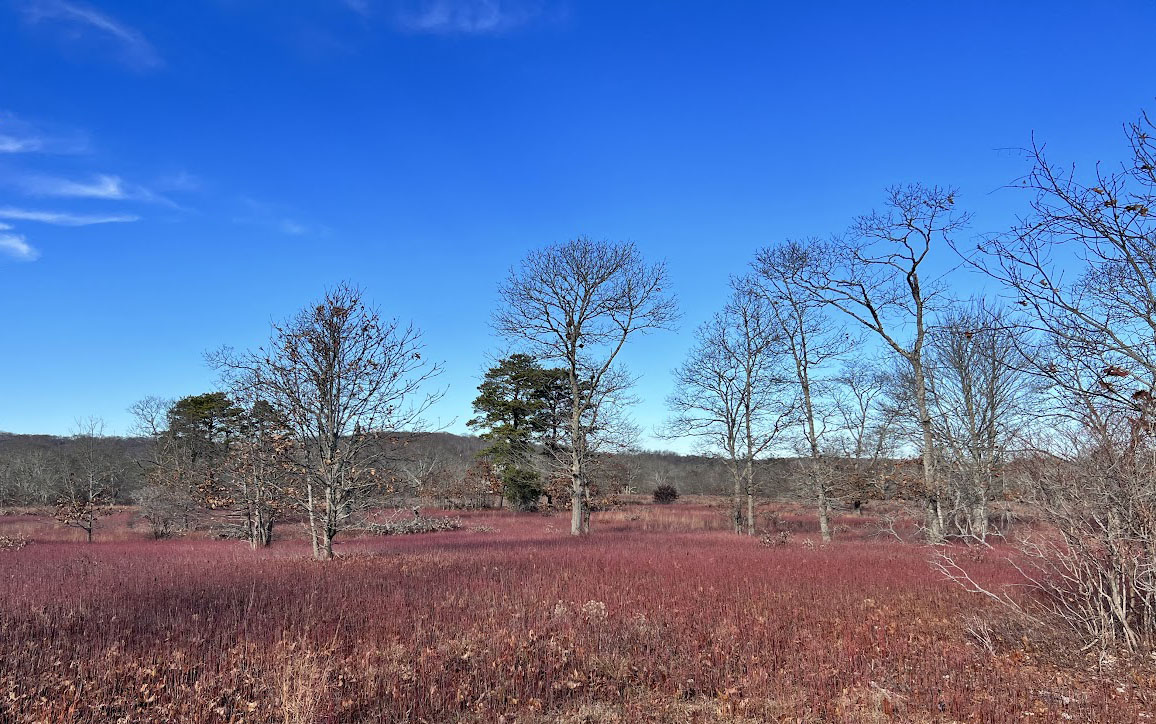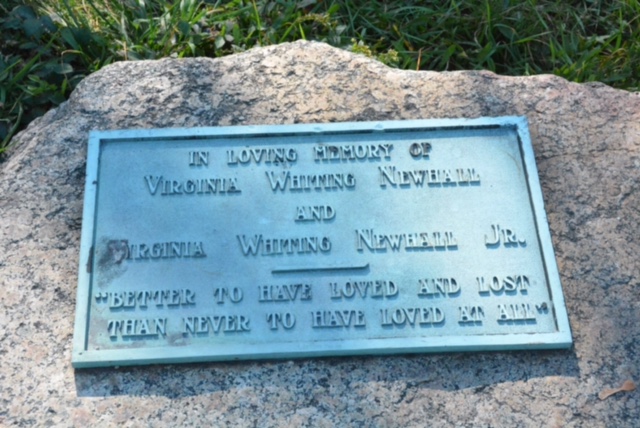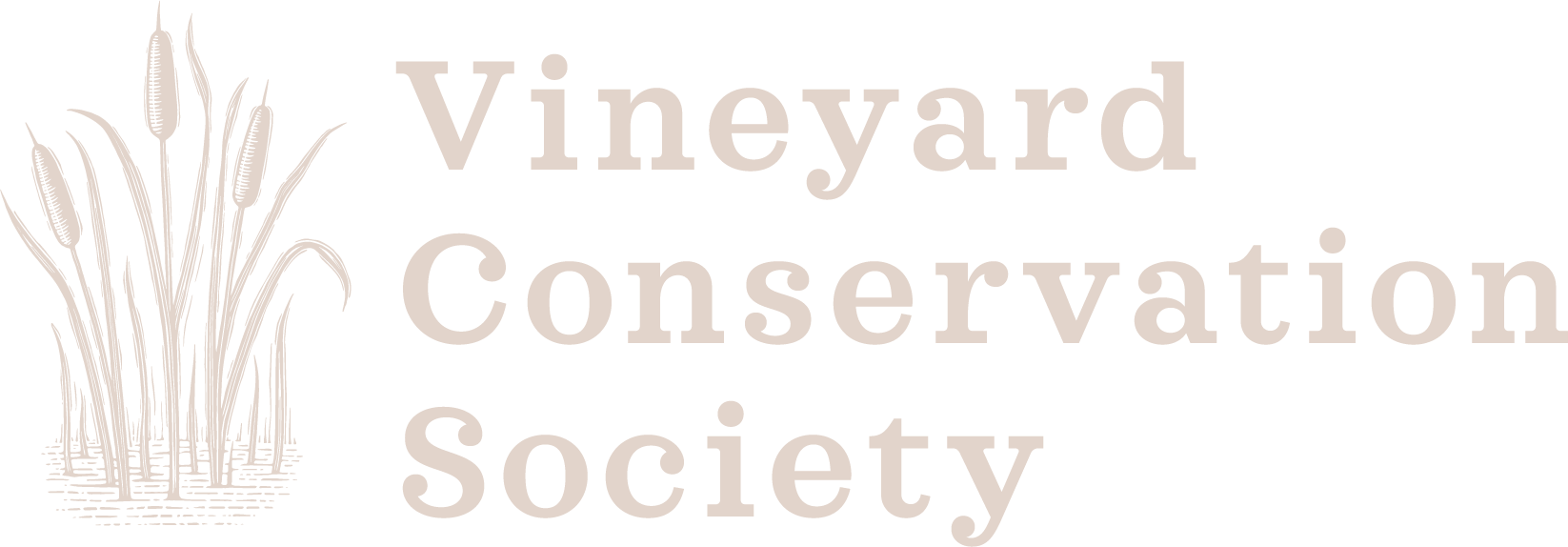
Frances Newhall Woods Preserve
History compiled by Marianne Jorgensen for VCS from sources including the Woods family, William Stewart, Brendan O’Neill, and others
In 1928, Frances Newhall Woods had bought her own home — the ice house on North Road that had belonged to Seven Gates Farm when it was a dairy. Situated in a tranquil spot above Fisher Pond, the family named it The Retreat. In one of her poems, Emma Mayhew Whiting eloquently described its peacefulness.
In 1982, Edwin Newhall (“Bob”) Woods made his first gift to the town: Brandy Brow Hill, the overlook at the intersection of State Road and the West Tisbury-Edgartown Road. His mother, Frances Newhall Woods, had bought the property in 1928 and built a memorial there to her sister Virginia, who died at the age of 24, and to her mother, Virginia Whiting Newhall, the daughter of West Tisbury patriarch Henry L. Whiting (1821 – 1897).

In 1991 Mr. Woods and his family donated a conservation restriction on 511.7 acres of woods, fields, and brook that Bob Woods had inherited from his mother. The restrictions have assured that the land will remain forever wild. Bounded by Middle Road, North Road, the Panhandle, and extending over the town line to include 12.7 acres in Chilmark, the Frances Newhall Woods Nature and Wildlife Preserve is today owned by the Nature Conservancy with the Conservation Restriction held by the Vineyard Conservation Society.
Just prior to the gift, the Woods family also donated to VCS a permanent agricultural restriction on a 23-acre parcel on the Panhandle. The Panhandle property was then sold at below market value to the Martha’s Vineyard Agricultural Society that had been founded by Henry Whiting in 1859. Today it is the site of the Agricultural Hall and fair.
The Woods property forms the centerpiece of a large mosaic of public and private conservation lands situated in the Mill Brook watershed. The area includes Waskosims Rock Reservation, a public conservation property owned by the Martha’s Vineyard Land Bank, a large tract at Seven Gates Farm and several other private properties with conservation restrictions, including the Polly Hill Arboretum.
At the time of the large CR gift from the Woods family in 1991, conservation leaders called it one of the most important protection efforts to date. The Nature Conservancy, an international land protection organization, had identified the Vineyard as a critical area needing preservation due to the high number of natural communities and globally rare species found on the Island. Locally, former VCS executive director Brendan O’Neill recalled, “It was a really significant event in Vineyard history at the time. It was the largest conservation restriction on a private landholding; it was tremendously generous and farsighted. In the early 2000s, a moth expert who spent a study period on the Woods property was astounded to find virtually every species of moth known in the region to visit his light in a single evening.
“The determination of Bob and Jeanne Woods to protect their property led to subsequent protections: the land bank with Waskosims, Polly Hill, and all the way west to the Mill Brook headwaters near the conserved Native Earth Teaching Farm,” O’Neill continued. “That whole corridor is a wonderful case study in the importance of patience in this kind of work.”
One Family’s Story
by William Stewart
Every conservation project is different. But each begins with people’s dreams of what they can do to protect the Vineyard’s environment, character, and quality of life.
As a grandchild of West Tisbury’s noted Henry L. Whiting, Frances Newhall Woods was eager to establish a family retreat in her Island home town. Early in the 20th century, she purchased several parcels of land between North and Middle Roads, including one extending along the Panhandle as far as its junction with State Road.
From the beginning, her goal was to protect the land as a sanctuary for wildlife. At the same time, she was deeply committed to the welfare of her historic Island community.
With its long history of agricultural use and easily accessible location, the parcel fronting on State Road was the logical place for concentrated human activity on the Woods’ land.
In a typically civic-minded gesture, in 1929 Mrs. Woods hosted an event on the site with trotting horses, a pony show, and other entertainments to benefit the newly-built hospital.
The Agricultural Society, founded by the family patriarch, was important to Henry Whiting’s descendants as well. Every year, family members would help organize the Annual Livestock Show and Fair, and all were eager to see the Ag Society flourish.
In time, Mrs. Woods’ holdings passed to her son, Edwin Newhall Woods, and his family. In order to honor his mother’s vision and protect the land in perpetuity, Mr. Woods turned to the Island’s only environmental advocacy organization, the Vineyard Conservation Society. He knew that VCS would serve as a disinterested intermediary, uniquely well-positioned to bring a complex project to fruition.
Meanwhile, the Ag Society had contacted Mr. Woods to talk about his property as well. The fair was outgrowing its old home in the village center, and the trustees were interested in acquiring the Woods parcel at the corner of Panhandle and State Roads as the site for a new fairground.
The Process
Every conservation project entails unique complexities. For the Woods family, the challenges were many—and that’s why the Vineyard Conservation Society got called in.
Every conservation restriction requires a “public benefit” to be approved. It can take many forms, such as protecting watersheds or scenic vistas, but the restriction’s grantors must provide something of value to the community.
A conservation restriction is a voluntary agreement between a landowner and a conservation organization. Its purpose is to protect the natural attributes of the land by restricting the uses and development that can take place on it. The conservation entity undertakes to make sure that the agreement is not violated, while current and future landowners continue to enjoy the property subject to the provisions of the restriction.
It was clear from the outset that a conservation restriction was the right vehicle for the Woods family. It would accomplish their conservation goals, and at the same time, allow them to retain ownership of their land.
VCS linked the fairground concept to the broader open-space protection plan. This was a formula for success.
Implementation and Results
Sometimes hard work pays off. Thanks to VCS facilitation, this multi-phase project ultimately yielded important gains both for the Island environment and for our community. To secure the new fairground for its intended purpose, VCS helped draft an agricultural preservation restriction, which Mr. Woods placed on the parcel before its sale. This restriction permanently protects the property from subdivision and industrial uses, while allowing the educational and other activities that the Ag Society has historically sponsored.
Once VCS had received the necessary approvals, Mr. Woods sold the land to the Ag Society for a bargain-basement price, and planning began for a new Agricultural Hall.
Meanwhile, VCS was guiding conservation of the other 500-plus acres of Woods land through the regulatory process, citing the new fairground as part of the open-space protection package. Since twelve acres of the property extends into Chilmark, approvals were needed from boards in two towns, as well as from state authorities. All were secured by VCS without cost to the landowner.
The Frances Newhall Woods Preserve was officially established in 1991. Now, you can be sure that the lovely view of wooded hills that you see on your left as you head up-Island along North Road, at the top of the first rise, will be there, unspoiled, for your grandchildren’s grandchildren to enjoy.
At the fairgrounds, in 1994 the Ag Society mobilized a mostly volunteer crew to dismantle and reconstruct the 100-year-old New Hampshire dairy barn that is so well known today. Public benefit? You bet! It’s a win-win solution, that has enhanced the well-being of both our community and our environment.
At VCS, much of our work involves facilitation. Early on, VCS was able to match the Woodses with The Nature Conservancy as a promising recipient of the restriction. Later, VCS helped draft the restriction, shepherded it through an extensive regulatory process, and advocated for the land-use planning approach that linked the project to broader regional objectives.
Acknowledgments: William Stewart; Martha’s Vineyard Museum/Oral History Project; Martha’s Vineyard Agricultural Society; Martha’s Vineyard Commission/Chris Seidel; Prudy Burt; Linda Hearn; Karen Huff; Mark Alan Lovewell; Alison Shaw; Matt Taylor; Penny Uhlendorf; and the Woods and Whiting families
